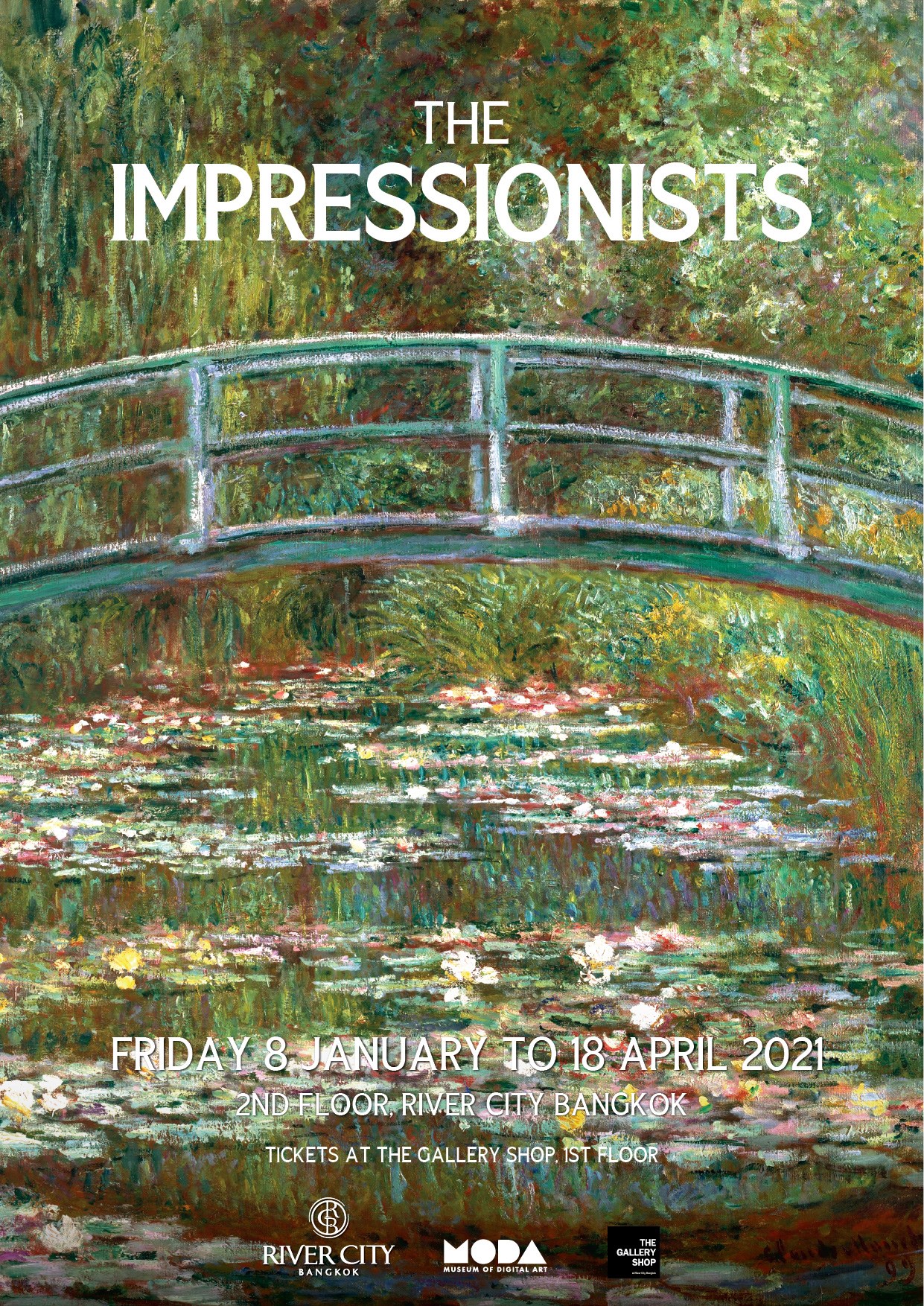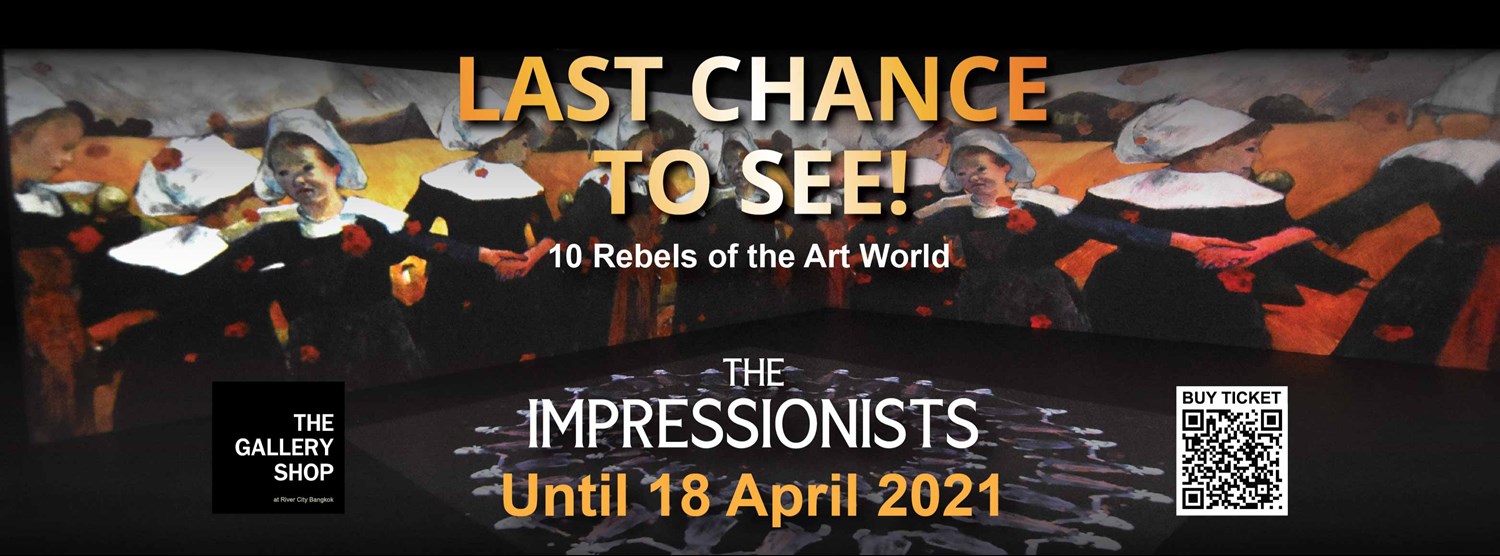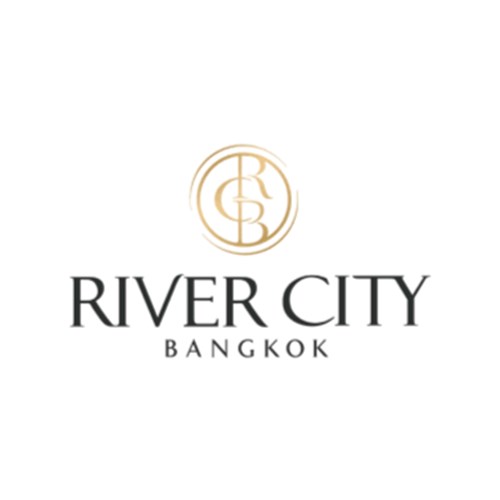
THE IMPRESSIONISTS
Museum of Digital Art at River City Bangkok
Friday 8 January to 18 April 2021
EXHIBITION SYNOPSIS
Gazing upon the some of the most important artworks of 19th Century Europe, you would be forgiven for thinking the artists lived a charmed and tranquil existence. You could not be more wrong. If fact, the world’s most celebrated artists of impressionism were rebels who were forced to draw deep on courage and fortitude to be recognized by their peers and collectors.
In the 19th century, France’s art scene was dominated by the Académie des Beaux-Arts, an association that set the strict standard for the style of work to be accepted in the Paris Salon, the Académie’s flagship exhibition and biggest commercial stage for aspiring artists at the time. However, a group of artists whose artworks were inspired by landscape and scenes of everyday life disagreed with the idea of Académie des Beaux-Arts. Instead they insisted on presenting their view of the world.
Of the Impressionist Period, the most famous are Eduard Manet, Claude Monet, Edgar Degas, Auguste Renoir, Henri De Toulouse-Lautrec, Henri Rousseau, George Seurat, Vincent Van Gogh, Paul Cezanne, and Paul Gauguin.
Opening to the public on Friday 8 January in the Museum of Digital Art on the second floor of River City Bangkok, the works of these ten titans of impressionism will be shown in the dynamic immersion format.
EXHIBITION TYPE
Multimedia: walk through exhibition that combines physical recreations of 19th century Paris street, café, art exhibition together with immersive projection and audio. Artist information panels will be displayed in the introduction rooms and selfie opportunities available throughout.
This multimedia exhibition is categorized into four rooms
Room 1: Paris Street
In the 19th century, France’s art scene was dominated by the Académie des Beaux-Arts, an association that set the strict standard for the style of work to be accepted in the Paris Salon, the Académie’s flagship exhibition and biggest commercial stage for aspiring artists at the time. However, a group of artists whose artworks were inspired by landscape and scenes of everyday life disagreed with the idea of Académie des Beaux-Arts. Instead they insisted on presenting their view of the world.
Of the Impressionist period, the most famous are Edouard Manet, Claude Monet, Edgar Degas, Auguste Renoir, Henri De Toulouse-Lautrec, Henri Rousseau, George Seurat, Vincent Van Gogh, Paul Cezanne, and Paul Gauguin.
Room 2 – Rebels of the Art
In the 19th century, Neoclassicism and Romanticism were the preferred artistic styles of France, advocated by Académie des Beaux-Arts. There was very little room for other artistic styles. This was especially true at the ‘Paris Salon’ exhibition, the Académie des Beaux-Arts’ stage for aspiring artists at the time. The Salon was strictly conservative, preferring the status quo. In the mid-19th century the Paris Salon turned away many paintings for not conforming to their ideals.
The impressionism movement formed when a group of painters including Claude Monet, Alfred Sisley and Pierre-Auguste Renoir started painting canvas in the open. Spontaneously painting outdoors rather than in a studio from sketches, the Impressionist would capture the beauty of landscapes and scenes of everyday life.
Room 3 – Café Guerbois
In breaking away from the Paris Salon and the oppression of the Académie des Beaux-Arts, many artists adopted the café as a place where they could discuss their ideas and develop their own art movement.
Located at 11 Grande Rue des Batignolles in the hillside district of Montmartre - the 18th arrondissement of in Paris - Cafe Guerbois played an important role in the formation of modern art. Centered on Édouard Manet, the group of artists gathered at the café on Sundays and Thursdays.
Room 4 - First Paris Exhibition
The most important event to arise from the discussions at the Café Guerbois was the first Impressionist exhibit of 1874 at Nadar’s studio. Organised by Monet, Pissarro, Degas, Renoir, Sisley and Berthe Morisot, the exhibition displayed 165 works by 30 artists. They included Monet’s Impression Sunrise, the painting that was responsible for coining the term ‘impressionism’. But the exhibition was a failure even though more than 3,500 people paid 1 French Franc to attend. In reality, most people visited the exhibition to sneer and scoff at the works on display. The newspaper critics were, on the whole, remarkably hostile.
Room 4 – International recognition
However, the impressionist persisted, showing their works in a total of eight historic exhibitions held between 1874 and 1886. Impressionism was not popular until Parisian art dealer and collector named Paul Durand-Ruel brought together more than 300 paintings of numerous Impressionist artists in an exhibition at the National Academy of Design in New York in 1886. In doing so, he introduced wealthy Americans to this modern French painting movement.
Room 4 Exit – Monet’s Garden
Claude Monet rented and eventually purchased a house in Giverny. Surrounded by garden and flowers, this place inspired him to paint his world-renowned series of paintings like Water Lily.
Immerse yourself in the the fantastic world of 19th century art epitomized by ten masters. The Impressionists is truly a beautiful symphony of light and sound worth to discover.
Stay updated on edutainment activities via
Facebook: River City Bangkok
Instagram: River City Contemporary
#TheImpressionists #MODAGALLERY #RiverCityBangkok


 ไทย
ไทย






